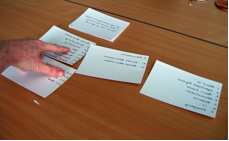Demystifying Information Architecture
From OZCHI
Contents |
ABSTRACT
There has been much confusion and misinformation regarding information architecture (IA) and its relationship with the longer established areas of user-centred design (UCD). Many experienced HCI people don’t feel well-equipped to take on the practical side of UCD in relation to web design. Likewise, web designers and developers are often in the dark regarding the principles behind what some “usability guy” tells them to do.
In this half-day tutorial, Patrick Kennedy will present the fundamentals of IA, which in essence is focussed on ensuring that information systems are structured in a way that makes sense to users. Specifically, the tutorial will be conducted in the context of organising and designing information systems such as websites, intranets and software applications. This tutorial will introduce IA, explain the fundamental principles and teach some simple techniques. The aim is to give participants a heads-up on the subject and point them in the right direction so they can integrate IA into their own work or just better collaborate with those already practicing IA.
Categories and Subject Descriptors
H5.4. Information interfaces and presentation (e.g., HCI): Hypertext/Hypermedia.
General Terms
Design, Human Factors.
Keywords
Information architecture, usability, usability testing, card sorting, paper prototyping, sitemap, wireframe, web design, website, intranet, training.
TUTORIAL OUTLINE
Participants will learn the concepts behind IA, as well as a set of useful techniques, whilst applying them to a mock project scenario. As such, the basic structure of the tutorial will follow a simplified IA methodology, consisting of research, design and validation phases. Content in the tutorial typically covers:
• definition of IA
• principles of IA and UCD
• general IA methodology
• overview of user research techniques
• balancing competing requirements
• explanations of commonly used IA jargon
• content categorisation schemes
• designing and labelling information structures
• designing navigational devices
• methods for validating design decisions
• preparing for subsequent design phases
Please note, this tutorial does not cover database design or technical platform architecture, even though the term ‘information architecture’ is often associated with those subjects within certain industries.
Practical techniques
During the tutorial participants will be involved in various hands-on activities that aim to demonstrate techniques and give them an idea of what they would find in a real world situation. This will include:
• card sorting
• site mapping
• paper prototyping
• low-level usability testing
These activities will form part of a mock project that will run the length of the tutorial, simulating a realistic, end-to-end IA process.
‘Show and tell’
Participants will be encouraged to share real information architecture challenges they have faced and collaboratively the group will discuss possible solutions based on what they have learnt in the tutorial. As many of these discussions as possible will be held in the time available.
Learning objectives
Participants who attend this tutorial will:
• learn the concepts underlying IA and web design
• learn a general methodology for approaching IA in a realistic situation
• understand the importance of uncovering user needs (and balancing those with business and other objectives)
• be able to demonstrate simple techniques and know when to apply them to the IA process
• have the confidence to start undertaking IA work
• be able to work more effectively with IA practitioners, including external consultants
• take skills and knowledge back to their workplace and share with their team
• gain a solid foundation on which to build further IA expertise
Target audience
This tutorial is primarily aimed at those who need to plan, structure or organise a website or other information system, but whom have no experience in IA, and those who simply have an interest in learning more about IA.
Hence, no experience in information architecture or user-centred design will be required, but participants should have reasonable experience in using the world wide web.
Academics looking to strengthen their practical knowledge of web design should find this tutorial useful, however anyone involved in the production of a website, intranet or software product will be well-served.
Typical participants include:
• HCI academics
• web designers (technical or creative)
• project or team managers
• writers, editors and other content creators
Please note, this is an introductory tutorial designed to build core skills, and is not suitable for intermediate or experienced IA or UCD practitioners.
About the facilitator
Patrick Kennedy is a web user experience specialist with over ten years experience in the digital media and web industry. His expertise is in information architecture, usability, user research and best-practice web design.As both a consultant and in-house practitioner, Patrick has delivered successful projects in a variety of different environments, including marketing and advertising, media, IT, manufacturing, not-for-profit and the public sector. He has worked with a variety of organisations, both in Australia and the United Kingdom. Patrick will draw examples from real-world projects to give insight into addressing common challenges and issues.
Currently, Patrick works for News Digital Media (part of News Limited) as a Senior Experience Architect, developing some of Australia's biggest websites.
Patrick holds a nationally recognised training qualification (TAA40104 Certificate IV in Assessment and Training), and has run workshops on information architecture for the general public as well as for in-house training.
He also speaks regularly at industry conferences (including OZCHI, Open Publish, OZ-IA, webDU) and has published many articles on information architecture and related topics.
Tutorial requirements
For best results the tutorial should be limited to:
• groups of 3 or 4 participants
• a total of 16 participants
Equipment required
The facilitator will supply computer, slideshow, a booklet for each participant and all writing materials needed for activities.
The conference organisers will need to supply the following:
• large desk or table for each group of participants
• data projector and screen
• whiteboard (preferably electronic)
• flipchart (pad and stand)
• internet connection
Should any of these items not be available, please advise the facilitator as early as possible.
Feedback from past tutorials
Participants of previous tutorials and workshops run by the facilitator have said:
"Excellent course and very timely for me. Hands on activities were very, very useful"
"Well structured, well presented, well paced, enjoyable"
"Very useful and informative - best seminar in a long time."
"Made IA seem more fun and creative, not so tedious."
"Great workshop. I had lots of my questions answered in the workshop's content. Great takeaways also!"
"Interesting, relevant to work being undertaken. Thought provoking."
"Good balance between theory and practice."
"Very practical and useful. I expect to use all the topics covered."
"Great course! Kept interest and useful exercises."
"Structure was good - balance of theory and practice."
"Energetic, fun learning."
"Very helpful & useful ideas to try."
"Great! Easy to understand concepts & the facilitator was very approachable."
